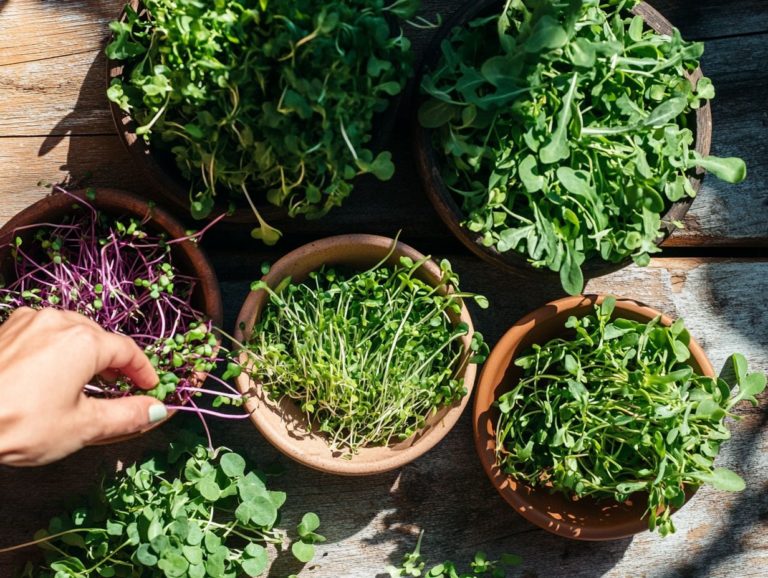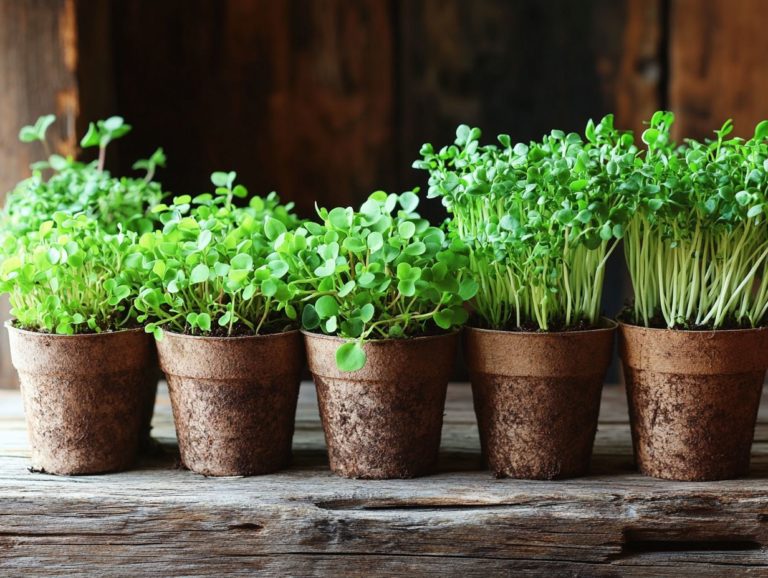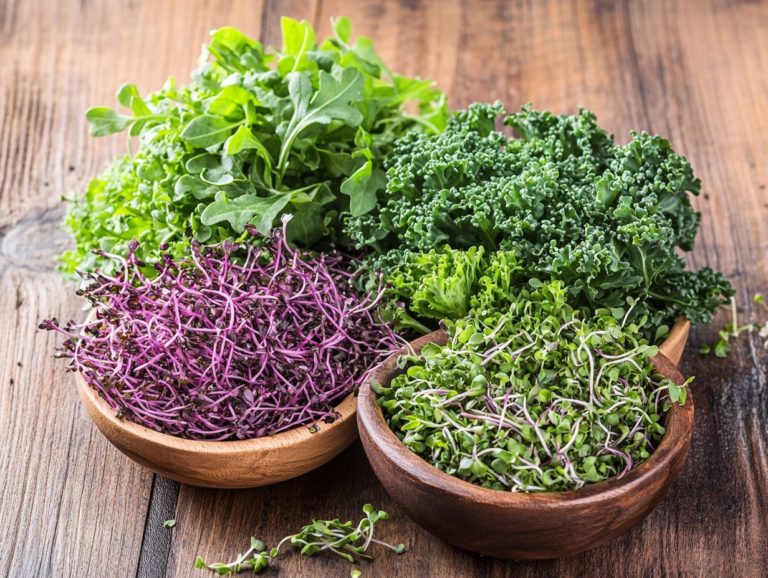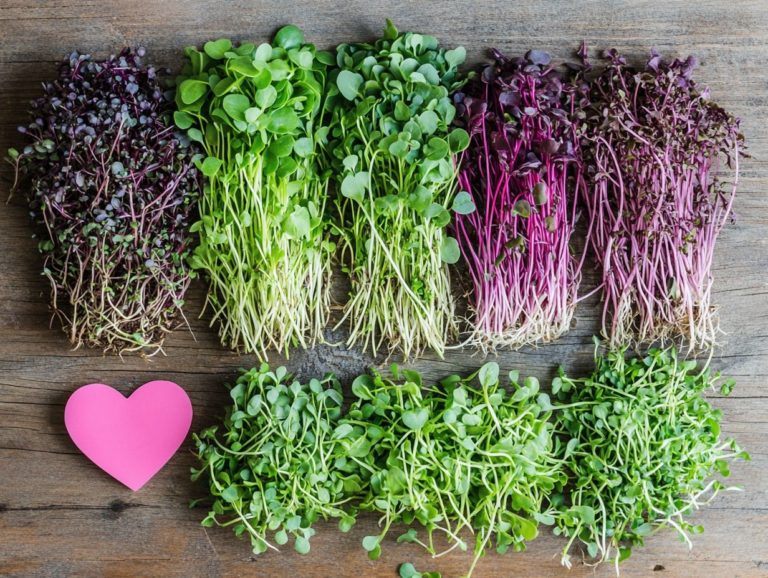The Benefits of Eating Microgreens Daily
Microgreens are more than just a trendy garnish. They offer an impressive burst of nutrition.
These tiny, vibrant greens delight your palate and are brimming with essential vitamins and minerals. They truly qualify as a superfood.
This exploration delves into what microgreens are and their remarkable health benefits. We ll also cover how to weave them into your daily diet for better well-being.
Whether you re curious about their nutritional value or eager to learn how to grow your own, this guide will enrich your journey!
Contents
- Key Takeaways:
- What are Microgreens?
- Nutritional Value of Microgreens
- Health Benefits of Eating Microgreens Daily
- How to Incorporate Microgreens into Your Diet
- Growing Your Own Microgreens
- Frequently Asked Questions
- What are microgreens and what are the benefits of eating them daily?
- How do microgreens compare to mature plants in terms of nutrition?
- What specific nutrients can be found in microgreens?
- What are the benefits of incorporating microgreens into a daily diet?
- Are there any specific health conditions that can benefit from daily consumption of microgreens?
- Are there any precautions to take when eating microgreens daily?
Key Takeaways:
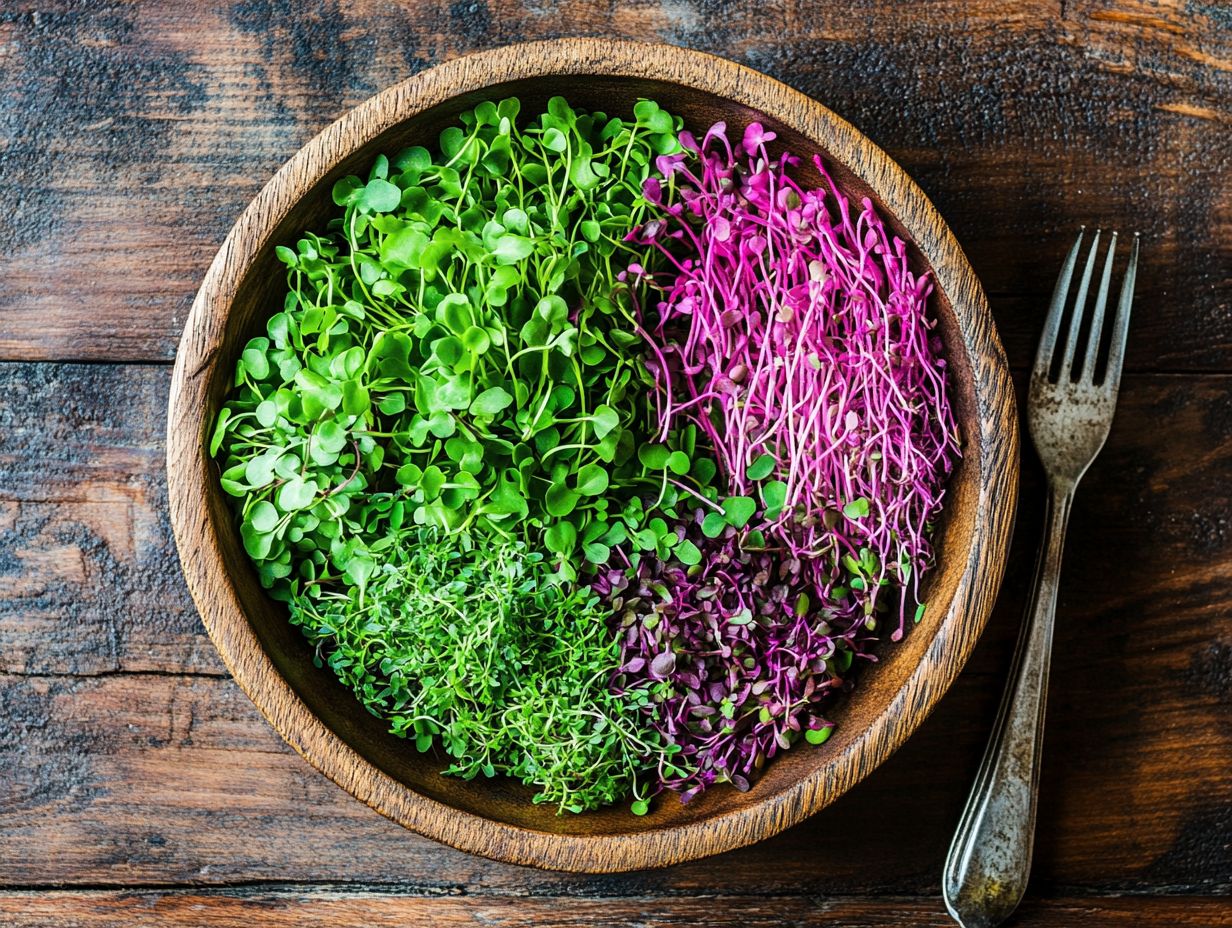
- Incorporating microgreens into your diet provides essential vitamins and minerals that improve health and combat insulin resistance.
- These greens can enhance digestion, boost your immune system, and lower the risk of chronic diseases like heart disease and diabetes.
- Growing your own microgreens is a simple and cost-effective method for ensuring a fresh supply of these nutrient-rich greens.
What are Microgreens?
Microgreens are young vegetables and herbs harvested early in their growth typically within 7 to 21 days after germination.
These vibrant, nutrient-dense seedlings are packed with concentrated nutrients and antioxidants. They make a fantastic addition to a balanced diet.
Registered dietitian Kayla Kopp explains that microgreens come in various types, including broccoli, fenugreek, and red cabbage. Each type brings unique flavors and health benefits to your meals.
Definition and Types of Microgreens
Microgreens are edible seedlings of plants harvested just after germination, usually at a height of 1 to 3 inches.
These young greens burst with flavor and nutrients, making them popular among chefs and home cooks. For instance, broccoli microgreens have a mild, slightly peppery taste that enhances salads and sandwiches.
Fenugreek microgreens offer an earthy flavor reminiscent of maple syrup, perfect for adding depth to Indian dishes.
Red cabbage microgreens not only add color to your plate but also provide a delightful crunch for tacos, grain bowls, or as a garnish.
Nutritional Value of Microgreens
Microgreens are highly valued for their exceptional nutrition. Packed with vitamins, minerals, and antioxidants, they surpass the health profile of their mature counterparts.
Including these tiny powerhouses in your diet gives you a nutritional boost that can enhance your well-being.
Key Vitamins and Minerals
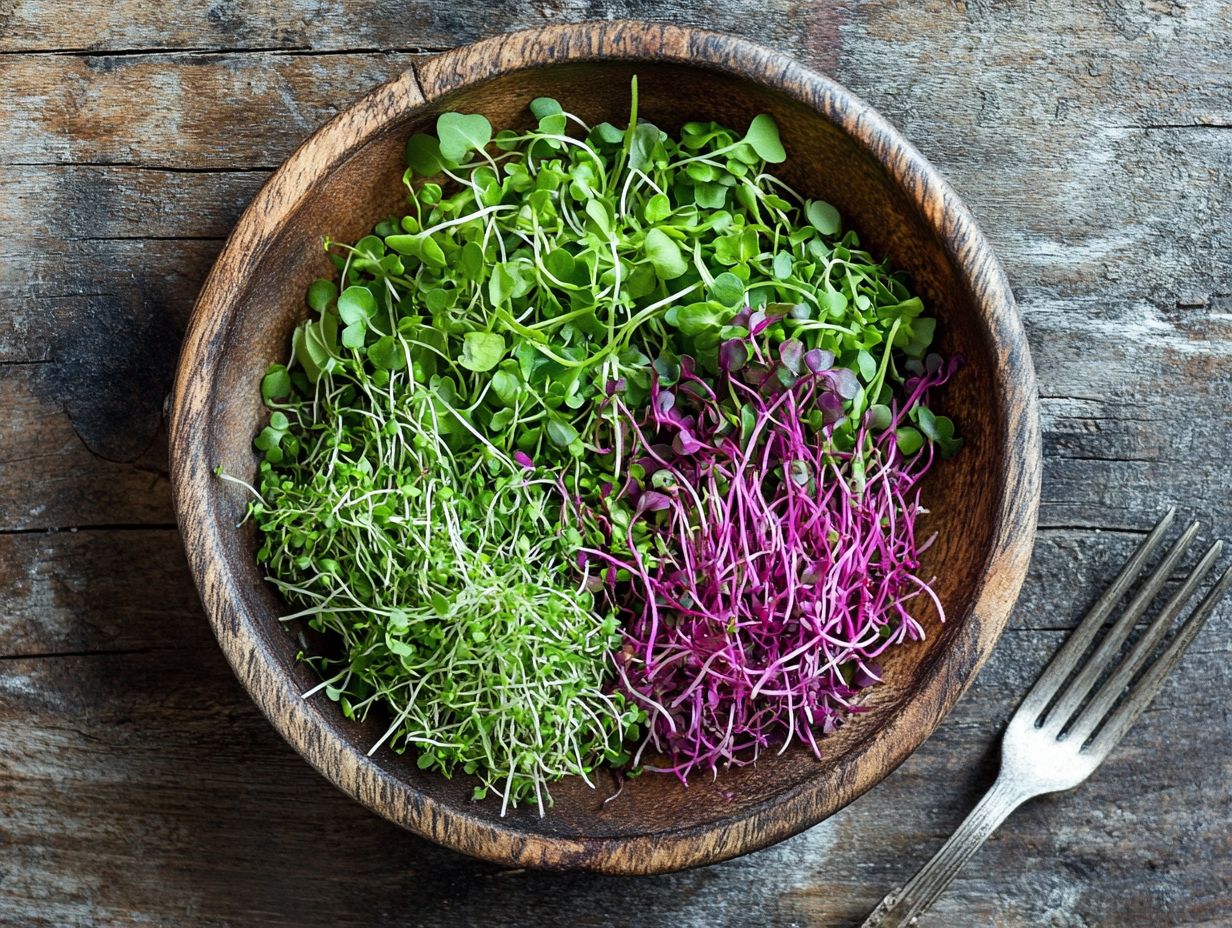
Microgreens contain key vitamins and minerals like iron, vitamin C, and various antioxidants essential for maintaining health.
These nutrients help combat iron deficiency and promote gut health. For example, iron supports hemoglobin production, preventing fatigue and weakness.
Vitamin C strengthens your immune system and boosts iron absorption, which is vital for enhancing overall wellness. Antioxidants in microgreens fight harmful effects of free radicals and may help prevent chronic diseases.
Together, these microgreen nutrients significantly contribute to a balanced diet and improved health.
Don’t miss out on these nutrient-rich greens start adding them to your meals today!
Health Benefits of Eating Microgreens Daily
Incorporating microgreens into your daily diet offers remarkable health benefits. They enhance digestion and bolster your immune system.
These nutrient-dense greens also play a vital role in reducing the risk of chronic diseases such as heart disease, obesity, and Type 2 diabetes.
Embracing this vibrant addition to your meals could transform not only your palate but also your overall well-being.
Improved Digestion and Immune System
Microgreens can significantly elevate your digestive health by helping you go to the bathroom easily due to their impressive fiber content.
They nurture the good bacteria in your gut, creating a thriving digestive environment.
These tiny greens are full of nutrients that support your immune system. When you add them to your meals, you re not just adding color; you re also adding important vitamins and minerals that enhance your body s natural defenses.
The fiber in microgreens also fosters the growth of beneficial gut bacteria, creating a harmonious environment in your digestive tract.
By enjoying them raw, you can optimize their nutritional benefits, ensuring that you absorb all the vitamins and antioxidants they have to offer. This perfect blend of fiber and nutrient density makes microgreens an invaluable addition to your diet, especially when considering the benefits of indoor microgreen growing.
Reduced Risk of Chronic Diseases
Regularly adding microgreens to your diet may lower your risk of chronic diseases, such as heart disease, obesity, and even certain types of cancer. This is thanks to their impressive content of sulforaphane and polyphenols.
These tiny greens are brimming with nutrients that can significantly enhance your health, underscoring the importance of making them a staple in your daily meals.
For example, varieties like broccoli and kale microgreens are particularly rich in sulforaphane, a compound that helps your body detoxify and combat oxidative stress.
Together, these components work harmoniously to reduce inflammation and may even influence gene expression linked to cancer cell growth.
Incorporating microgreens into your dishes not only adds vibrant flavors and textures but also increases your nutrient intake without piling on excessive calories. This makes them a savvy choice for maintaining your overall health.
How to Incorporate Microgreens into Your Diet
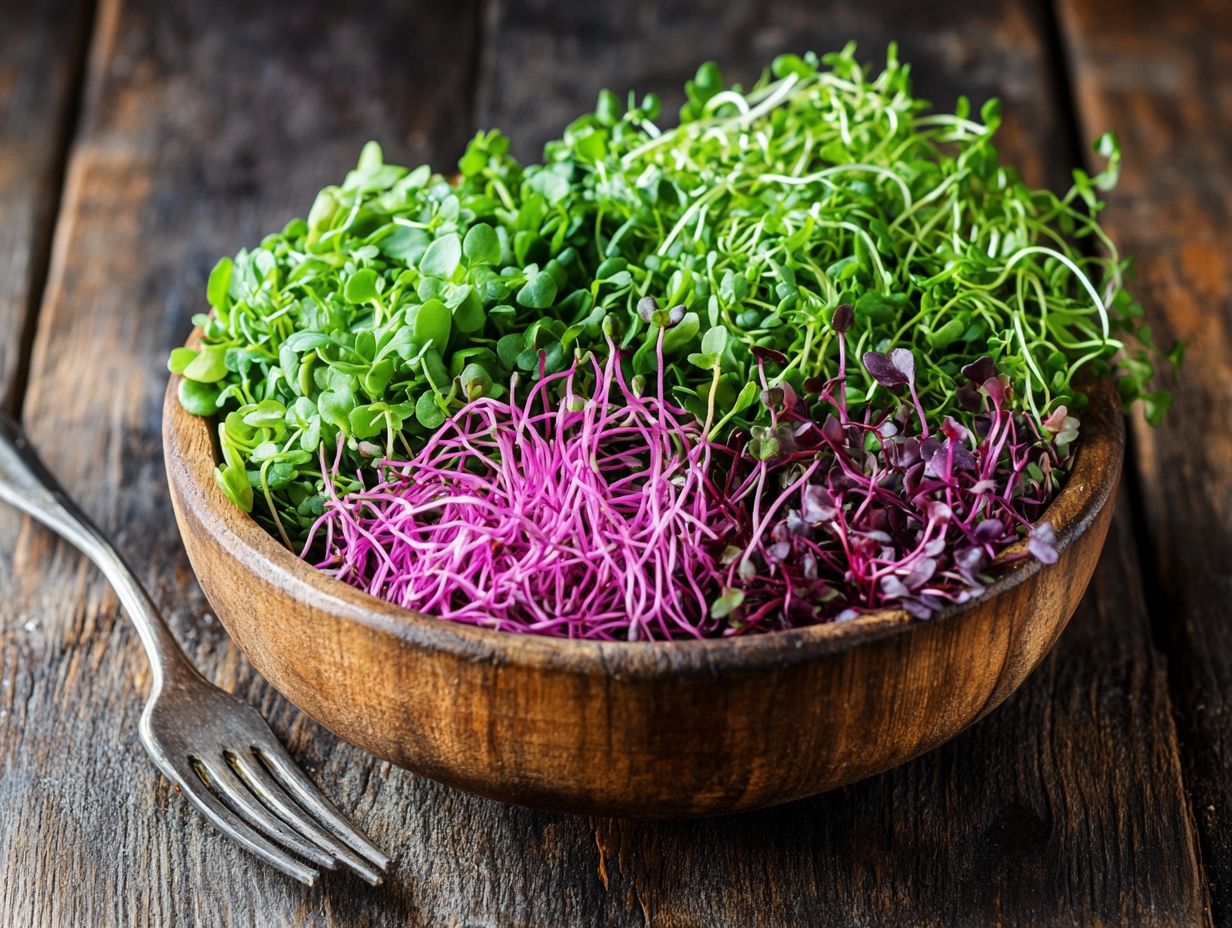
You ll be amazed at how easy it is to add microgreens to your diet! They can transform your meals into vibrant vegetable confetti that delights both the eyes and the palate.
Imagine turning simple salads, sandwiches, and omelets into culinary masterpieces with these tiny powerhouses.
Recipes and Meal Ideas
Discover an array of delightful recipes and meal ideas that skillfully incorporate microgreens, transforming your everyday dishes into nutrient-rich options that truly tantalize the palate.
Consider a refreshing microgreen salad topped with creamy avocado, zesty citrus segments, and a light vinaigrette, or a hearty sandwich layered with smoked turkey, a kick of horseradish sauce, and a generous handful of peppery arugula microgreens.
Elevate your breakfast with scrambled eggs enriched by a medley of microgreens and a sprinkle of tangy feta. By weaving microgreens into your daily meals, you not only enhance flavors but also enjoy a wealth of health benefits, including improved digestion and a boosted immune system. For those interested in maximizing their harvest, consider exploring the benefits of growing microgreens vertically.
Growing Your Own Microgreens
Growing your own microgreens is a truly rewarding endeavor that demands little space. You can easily achieve this by following a straightforward step-by-step guide.
This makes it an accessible pursuit for anyone eager to cultivate their own seedlings and enjoy the fresh, vibrant flavors they bring.
Ready to add microgreens to your meals? Let s dive into some delicious recipes!
Step-by-Step Guide and Tips
To successfully grow microgreens, you ll want to follow this comprehensive step-by-step guide that covers everything from seed selection to germination. This guide includes the ongoing care of your seedlings.
Growing microgreens is not just a rewarding endeavor; it s also an educational journey that opens up a world of possibilities for both novices and experienced gardeners. Cultivating fresh greens brings immense joy right in your home.
Begin by selecting the right seeds; your options range from aromatic basil to peppery radish and sunny sunflower, each bringing its own unique flavors and nutrients to your table.
Once you’ve chosen your seeds, prepare your growing medium whether it s rich soil or a soilless mix (a growing medium without soil, often made from peat or coconut coir) making sure it s moist but not waterlogged. After sowing the seeds, be diligent in providing adequate light and proper watering to nurture your seedlings. In a matter of days typically between 7 to 21, depending on the variety you ll be ready to harvest.
With attentive care and a thoughtful approach, get ready to enjoy the crisp, flavorful bites of your very own homegrown microgreens.
Frequently Asked Questions

What are microgreens and what are the benefits of eating them daily?
Microgreens are young, tender versions of plants like herbs, vegetables, and grains. They are full of nutrients and health benefits when eaten daily, such as improved digestion, enhanced immune system, and increased energy levels.
How do microgreens compare to mature plants in terms of nutrition?
Microgreens are actually more nutritious than their mature counterparts. Studies have shown that they can contain up to 40 times more vitamins and minerals than fully grown plants, making them a powerhouse of nutrients for daily consumption.
What specific nutrients can be found in microgreens?
Microgreens are rich in vitamins A, C, and K, as well as minerals like iron, potassium, and calcium. They also contain beneficial plant compounds like antioxidants and polyphenols, which have anti-inflammatory and disease-fighting properties.
What are the benefits of incorporating microgreens into a daily diet?
Aside from the numerous health benefits, microgreens add flavor, texture, and color to dishes, making them a great addition to any meal. They can be easily grown at home, making them a convenient and cost-effective way to boost daily nutrition.
Are there any specific health conditions that can benefit from daily consumption of microgreens?
Yes, microgreens have been shown to aid in managing or preventing certain health conditions, such as diabetes, heart disease, and certain types of cancer. They can help with weight management and maintain a healthy gut microbiome.
Are there any precautions to take when eating microgreens daily?
While microgreens are generally safe for consumption, it’s important to wash them properly before eating to avoid any potential contamination. Those with specific allergies or sensitivities should consult with a healthcare professional before incorporating them into their daily diet.


